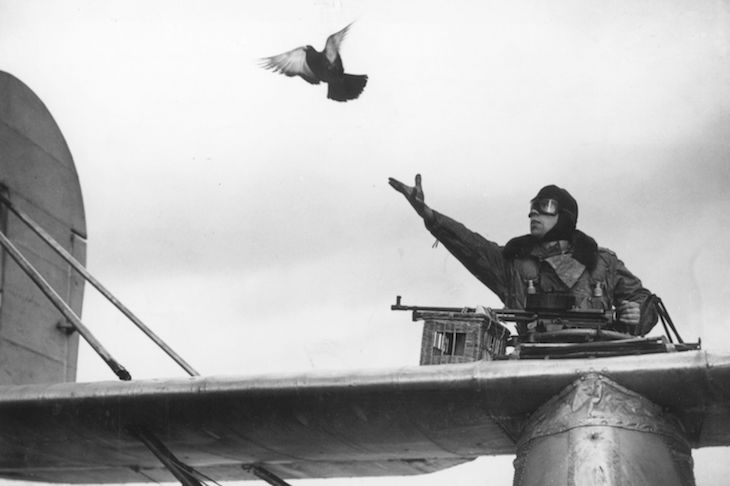Operation Columba was one of the most secretive arms of British Intelligence during the second world war. Between April 1941 and September 1944, its agents made 16,554 drops over an area stretching from Copenhagen to Bordeaux. Amongst Columba’s successes was the mapping of Belgium’s entire coastal defence system, 67 kilometres worth of priceless, minutely detailed information. Columba was the province of a specially created Secret Service division, M114 (d), which received its first message from occupied Europe on 10 April 1941. The correspondent ended his message stoutly: ‘I am, and will always remain, a Frenchman.’
That spirit of defiance, expressed by an ordinary, anonymous citizen who risked his life to send his communication, encapsulates the sense of danger, drama and poignant humility which Gordon Corera brings to his extraordinarily well researched history of Columba’s operations. The unit’s agents were pigeons, and in Secret Pigeon Service Corera succeeds admirably in detailing their hitherto unsung contribution to the Allied victory.
Unlike many other branches of espionage, pigeon intelligence has failed to attract a glamorous legend. No Fleming or Le Carré has immortalised the service of birds whose homing instinct, so usefully exploited by Columba, remains to this day scientifically inexplicable. Pigeon communication has an honourable history: the Baghdad caliphate made use of it in the 12th century, the Reuters news service began with avian couriers, and the besieged citizens of Paris employed it during the siege of 1870.
Nonetheless, there remains something Pooterish about the lowly pigeon, that whiff of suburban pathos upon which the comedian Graham Fellowes capitalised so brilliantly in his spoof 1998 Eurovision entry ‘Pigeons in Flight’. Corera’s attempts to inject jeopardy into his narrative can sometimes result in rather touching hyperbole — William Osman, one of the brains behind Columba, possessed an ambition which ‘would drive deep fissures within the pigeon world’, a world often ‘riven by bitter infighting’.
The story of the Belgian resistance group, which is the focus of the book, Leopold Vindictive, in fact requires no such window-dressing. Led by the Catholic priest Josef Raskin, the group succeeded in using pigeons dropped by the RAF in a mission of pride and subversion which produced essential information for British forces, but which ultimately cost three of them their lives.
A talented artist, Raskin had worked as an observer during the first world war, sketching maps of enemy positions. This skill, and the exquisitely tiny handwriting he had perfected as a missionary in Shanghai, enabled Leopold Vindictive to condense pages of intelligence into folded documents the size of postage stamps, carried in cylinders attached to the pigeons’ legs. Raskin’s intelligence and gift for improvisation gave the reports their precision, but the courage of the other members of the group, the Debaillie family, also gleams from the pages. Anne Sebba’s excellent 2016 study, Les Parisiennes, highlighted the importance of women’s role in covert resistance; here Corera pays tribute to Marie and Margaret Debaillie, whose talent for everyday espionage proved essential to Vindictive’s success.
Pigeon communications had a 12 per cent success rate, which despite MI6’s sniffy attitude to ‘the Columba racket’ was no worse than many other methods. One of the surprises of this book is its revelation of how haphazard, not to say shambolic, were the intelligence services’ preparations in the run-up to the war. The sheer speed of the Nazi Blitzkrieg across the Low Countries found them hopelessly unprepared; MI6 in Brussels hurled their teleprinter out of the window to prevent documents falling into enemy hands, while agents took turns to guard a bonfire of intelligence with the single office Luger. In comparison with the average period of return for an agent report at the mid-point of the war of four months (by which time information was frequently superannuated), pigeons were fast — Columba could turn round a drop in just 36 hours.
Columba’s success provoked surreal existential questions at the end of the war. The Parliamentary sub-committee on pigeons was wound up in 1950, but not before a vigorous debate as to whether pigeons ought to be awarded medals, like guard dogs. Since pigeons were following instinct, the Air Ministry suggested, could they be considered brave? Their champions countered that pigeons could choose to overcome risk and that therefore their ‘voluntary determination’ was worthy of decoration.
Inevitably, there is a risk of bathos in recounting Columba’s history, and Corera does not always avoid it. Yet his meticulous unravelling of the workings of the secret pigeon service makes his book a significant, if idiosyncratic, contribution to military history. And at its heart is an element which grander accounts of the war often overlook. Groups like Leopold Vindictive represented the silent thousands whose small acts of resistance, at the risk of their own lives, contributed immeasurably to victory. Whatever the status of the pigeons’ instinct, that urge to return home, and the human hope it represented, takes on a peculiar resonance when measured against the enormity of the Nazi war machine.






Comments